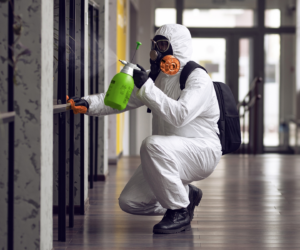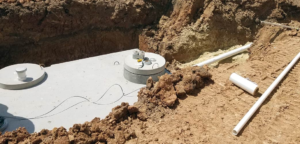Mold growth eats away at building materials and can cause health problems for home residents. Removing mold as soon as it appears is important to prevent further damage and future growth. Contact Ace Mold now!
Wearing rubber gloves, goggles, and a respirator is crucial when cleaning mold from painted surfaces. Ventilation is also important; open windows and use a fan to direct air from the affected area while working.

Once the mold is gone, cleaning the area thoroughly is important. This will help ensure that the problem is really solved, and reduce your family’s exposure to mold spores. Continual exposure to these spores can cause respiratory distress, allergic reactions, and serious health problems in sensitive individuals.
This is also a great time to go through your belongings and throw away items that aren’t salvageable. Items that have been contaminated by mold should be bagged and disposed of properly. This includes drywall, carpeting, insulation and more.
During this stage, professionals will use a commercial biocide to spray the affected areas. This will kill the mold spores and prevent them from spreading. Non-porous surfaces, such as tubs, metals and countertops, will be cleaned and sanitized. Porous materials like drywall and wood wall studs will be treated with an antimicrobial product to eliminate mold spores and prevent re-growth.
The sanitizing process is followed by a thorough dry down and dehumidification. This process is regulated by EPA standards, and it’s crucial for preventing future mold growth.
Moisture is one of the most common causes of mold growth, and it’s important to identify and fix the root cause of your problem. This may involve fixing leaks, improving ventilation, or addressing structural issues. It’s also important to regularly monitor the area for signs of moisture, such as musty odors or water stains.
After the sanitizing and dry down process, you can return to your home. However, it’s recommended to take at least 2-3 days to let the air clear and prevent re-growth of the fungus. It’s also a good idea to invest in a dehumidifier and fans, especially in rooms that are more prone to mold, such as the basement and attic.
Mold spores can cling to clothes, animal fur, vehicles and just about anything else, making it hard to keep them out of your home. You can further reduce spores by keeping an eye on your belongings, and having regular cleaning services performed by a qualified professional. This is a great way to keep your home healthy and safe for your family!
Remove the Moldy Materials
The next step in mold remediation is to remove any items that are infected with mold. This can include drywall, carpeting, ceiling tiles and more. It’s important to take special care when handling these materials. This is because the spores that are released when you handle these materials can spread throughout the air and can be inhaled by those who live or work in the affected area. It is recommended that you wear gloves, long sleeves and pants, and a dust mask when working with any contaminated materials. It is also a good idea to use an N95 respirator when cutting into or scraping any drywall, carpet or other material with mold growth. You should also be sure to keep the area well ventilated while working to prevent the spores from dispersing into other areas of your home.
When dealing with any porous or absorbent materials, like drywall or carpeting, you should first spray them down with water to reduce the number of spores that are released during the removal process. You should also use a vacuum cleaner with an HEPA filter while handling these materials. You should also use a microbial cleaner or biocide on these materials to kill any spores that may still be alive and to prevent them from returning once the area has been cleaned.
If any of the materials are beyond salvageable, they should be thrown away as soon as possible. This helps to ensure that the mold spores are not spread to other parts of the house and can cause further damage. If you don’t have any other choice, the contaminated materials can be sealed in plastic bags and then disposed of.
In addition to cleaning and removing the impacted materials, you should also make any necessary repairs to stop the problem from coming back. It is important to fix the source of the moisture and any other factors that are allowing the fungi to grow. For example, if you have a plumbing leak, this should be repaired immediately to help prevent the formation of mold. Additionally, you should make a point of being observant and looking for any signs of mold in the future, especially around humid areas like laundry rooms and basements.
Dispose of the Moldy Materials
Once the mold has been remediated, the next step in the process is to dispose of any items that were contaminated. This includes drywall, carpeting, and insulation. These materials should be bagged and labeled as “Mold-Contaminated.” The bags can then be disposed of in a landfill that accepts these types of waste.
In addition, the area needs to be cleaned to make sure that all of the mold spores are removed. This can be done using a variety of cleaning methods, depending on the type of material and the severity of the mold growth. During this step, it’s important to use protective equipment to avoid exposure to the mold spores. This should include disposable gloves, masks, and eye protection.
After the materials have been cleaned, they need to be sanitized and deodorized. This is to prevent the spread of mold spores and to remove any repugnant smells. This process may need to be repeated several times.
It’s also a good idea to replace any items that were damaged by the mold, such as wallpaper and insulation. The spores from these materials can easily spread to other areas of the home. It’s also important to replace any food that has been contaminated by mold, as the spores from the mold can spread to other foods in the refrigerator or pantry.
While it is heartbreaking to throw out some of your possessions, it’s important to protect yourself and your family from the risks that come with breathing in mold spores. To help you decide what stays and what goes, consider whether the item is replaceable or sentimental. If it’s an heirloom, try to find another way to preserve the meaning of the item without exposing your family to mold spores.
It’s important to address the moisture problem that caused the mold growth in the first place. This can be done by repairing any leaks and limiting moisture buildup in the area. The best thing to do is to address the moisture issue as soon as possible. Otherwise, the mold may continue to grow and cause further damage.
Remediate the Area
Molds can cause various health issues in humans, including respiratory difficulties. These problems are more likely to affect vulnerable individuals, such as infants and children, the elderly, or people with immune deficiencies. Molds need moisture, warmth, and organic matter to grow. They can be caused by natural disasters, a leaking pipe, or excess humidity that is not vented properly. If left unaddressed, a mold outbreak can spread throughout the building and lead to further damage.
Mold remediation professionals will use a variety of tools to remove and kill mold spores, as well as prevent new growth. These include HEPA-approved vacuums, dryers, and other airflow methods. They will also spray the area with an EPA-approved biocide, which makes the spores sterile. This is done to ensure the safety of the occupants and anyone else who visits the home or business.
During this stage, the restoration company will also wipe down and scrub all non-porous surfaces to get rid of any visible mold spores. This may involve the use of a stiff brush or a cloth. If a surface is porous or absorbent, such as drywall or ceiling tiles, it is important to dry the area completely before refinishing or painting. The professionals will also inspect the entire building for any areas of moisture or mold, as well as test the air quality with a special machine.
The final step in the mold remediation process is to re-inspect the area and test for air quality, ensuring the area has been fully remediated. This inspection includes a review of the test results and identifying any areas that still need attention. The professional will recommend a plan to fix the issue and prevent future mold growth.
It is impossible to eliminate all mold spores in the air, but mold remediation can help to control indoor humidity and promptly address water damage. Proper maintenance and moisture control can help to keep molds from growing again, so it is important to take proactive measures to protect your home or business. If you notice any signs of mold, contact On the Spot Cleaners for a free inspection.
